From MyLovelyBeads.com Team
In the fifth issue of our MyLovelyBeads.com newsletter:
If you have any questions or suggestions please contact
us at info@mylovelybeads.com.
Best regards,
MyLovelyBeads.com Team
|
 |

Stone of October:
OPAL
Represents purity and intensity. It assists in emotional and mental
balance, calms the inner soul. Excellent stone for progress, expansion,
and development. Helps one connect the conscious and subconscious,
providing for a clearing understanding of oneself. Zodiac signs: Cancer
(Crab), Libra (Balance), Pisces (Fish), Scorpio (Scorpion).

|
|
Opal - mineraloid gel
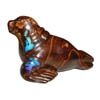 Opal is a
mineraloid gel, the water content sometimes is as high as 20%, but is
usually between three and ten percent. Opal color ranges from clear through white,
gray, red, yellow, green, blue, magenta, brown, and black. Of these hues, red
and black are the most rare and dear, whereas white and green are the most common.
The word opal comes from the Latin OPALUS, by Greek OPALLIOS, and is
from the same root as Sanskrit UPALA(s) for "stone", originally a millstone
with UPARA(s) for slab.
Opal is a
mineraloid gel, the water content sometimes is as high as 20%, but is
usually between three and ten percent. Opal color ranges from clear through white,
gray, red, yellow, green, blue, magenta, brown, and black. Of these hues, red
and black are the most rare and dear, whereas white and green are the most common.
The word opal comes from the Latin OPALUS, by Greek OPALLIOS, and is
from the same root as Sanskrit UPALA(s) for "stone", originally a millstone
with UPARA(s) for slab.
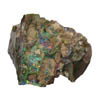 Opal is truly amorphous, but precious opal has a structural element. At the micro
scale precious opal is composed of silica spheres, that produce a variable interplay
of internal colors by causing the interference and diffraction of light passing
through the microstructure of opal. The term opalescence is commonly and erroneously
used to describe this unique phenomenon, which is correctly termed play of color.
Contrarily, opalescence is correctly applied to the milky, turbid appearance of common
opal, that does not show a play of color.
Opal is truly amorphous, but precious opal has a structural element. At the micro
scale precious opal is composed of silica spheres, that produce a variable interplay
of internal colors by causing the interference and diffraction of light passing
through the microstructure of opal. The term opalescence is commonly and erroneously
used to describe this unique phenomenon, which is correctly termed play of color.
Contrarily, opalescence is correctly applied to the milky, turbid appearance of common
opal, that does not show a play of color.
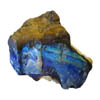 Besides the gemstone varieties that show a play of color, there are other kinds of
common opal that don't have this effect, such as the milk opal, milky bluish to greenish;
resin opal, honey-yellow with a resinous luster; wood opal; menilite brown or gray;
hyalite, a colorless glass-clear opal; geyserite, deposited around hot springs or
geysers; and diatomite, the accumulations of diatom shells or tests. Other varieties
of opal are: fire opal is a translucent to semi-opaque stone that is generally
yellow to bright orange and sometimes nearly red; peruvian opal is a semi-opaque
to opaque blue-green stone found in Peru; boulder opal consists of concretions
and fracture fillings in a dark siliceous ironstone matrix.
Besides the gemstone varieties that show a play of color, there are other kinds of
common opal that don't have this effect, such as the milk opal, milky bluish to greenish;
resin opal, honey-yellow with a resinous luster; wood opal; menilite brown or gray;
hyalite, a colorless glass-clear opal; geyserite, deposited around hot springs or
geysers; and diatomite, the accumulations of diatom shells or tests. Other varieties
of opal are: fire opal is a translucent to semi-opaque stone that is generally
yellow to bright orange and sometimes nearly red; peruvian opal is a semi-opaque
to opaque blue-green stone found in Peru; boulder opal consists of concretions
and fracture fillings in a dark siliceous ironstone matrix.
Until the nineteenth century the only source of precious opal known to Europeans was
the mining district in Slovakia. Opal without play of color is very common and can be
found all over the world, unlike precious opal deposits that are in greater scope
found today only in Australia, USA, and Mexico. Australia produces around 97% of
the world's opal. Boulder opal is found sporadically in western Queensland, Australia.
Fire opal is found mostly in Mexico and Mesoamerica. Other significant deposits of
precious opal around the world can be found in the Czech Republic, Slovakia, Hungary,
Turkey, Indonesia, Brazil, Honduras, Guatemala, Nicaragua and Ethiopia.
Opal facts
1. The opal is the official gemstone of South Australia and the Commonwealth of Australia.
2. Australia country's women's national team in basketball is nicknamed "The Opals".
3. The official state gemstone for Nevada is precious black Fire Opal, in recognition of
the black opal found in Virgin Valley, Humboldt County, Nevada.
4. The largest black opal in the Smithsonian Museum, possibly worth in excess of $1 million,
comes from the Royal Peacock Opal Mine in the Virgin Valley.
|
New on MyLovelyBeads.com
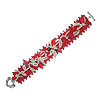
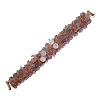
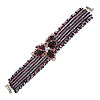
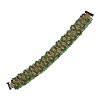
If you have looked through the site and have not found that perfectly
glorious MyLovelyBeads.com design for an upcoming event, or to go
with your favorite outfit, place a custom order to discuss your needs
with us. We love to design for specific individuals, incorporating
their energy and personality into the piece. Many of the spectacular
pieces you can see on the site are the result of a custom order that
undoubtedly inspired a higher level of creativity. There are just a
few steps to place a
custom order.
|
Featured artist
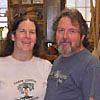 Joan Jensen and Ernie Morse of Tazwood Creations
create beads from native, exotic, and historic woods. Every bead is made by hand,
using most of the machines in the work shop! Some of the bead shapes, such as the
rectangular flats, are made with the table saw, router, and drill press, then sanded and
finished by hand. Triangular prism beads require precise measuring and extreme caution
on the table saw. Most of the bead blanks are first cut on a band saw, and then turned
on a wood lathe using highly sharpened turning tools at speeds of more than 3900 RPM. The
beads are then hand sanded to at least a six hundred grit, and finished accordingly.
Depending on the wood species and its intended use, we use one of several different oils,
waxes, shellac, lacquer, resins, and sometimes dyes. A final buffing with three different
compounds completes the creation of a bead.
Joan Jensen and Ernie Morse of Tazwood Creations
create beads from native, exotic, and historic woods. Every bead is made by hand,
using most of the machines in the work shop! Some of the bead shapes, such as the
rectangular flats, are made with the table saw, router, and drill press, then sanded and
finished by hand. Triangular prism beads require precise measuring and extreme caution
on the table saw. Most of the bead blanks are first cut on a band saw, and then turned
on a wood lathe using highly sharpened turning tools at speeds of more than 3900 RPM. The
beads are then hand sanded to at least a six hundred grit, and finished accordingly.
Depending on the wood species and its intended use, we use one of several different oils,
waxes, shellac, lacquer, resins, and sometimes dyes. A final buffing with three different
compounds completes the creation of a bead.
Visit Joan and Ernie's website at
www.TazwoodCreations.com to see a multitude of hand made wooden beads, pens, bowls,
vessels, and finished jewelry. Do not limit yourself to the selections currently in stock,
though, as custom orders with your choice of wood and shape are encouraged, usually at
no additional costs.
|
Do you know? Silver
When choosing a piece of jewelry, you always pay attention at the materials. If you see a
white metal some parts are made of and ask a vendor about materials, you often hear -
silver! And that can be not a pure silver, but silver plated or silver filled. Do you know
the difference between them?
Silver filled is a mechanical bonding with a silver alloy of at least 92.5 percent
fineness. The bonding must be equal to at least one-twentieth of the metal in the article.
This can also be called silver overlay, but never silver plate.
Silver plate is a fine silver film deposited on a base metal by electrolysis, in the
same kind of electrically-charged bath used to make gold electroplate. The film can be as
thin as seven millionths of an inch. A silver plate item cannot be called Sterling or marked
as silver.
Sterling Silver (SS) items are made of 92-1/2% pure silver and 7-1/2% copper
or other alloy proportions fixed by law. In time Sterling color will take on an "antique"
look. Fine silver = .999 or 100% pure silver.
|
Russian beaded icons
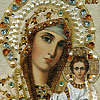 The art of Russian icon painting is known worldwide. As a general rule, these icons
strictly followed models and formulas hallowed by Byzantine usage, but as time passed,
the Russians widened the vocabulary of types and styles far beyond anything found
elsewhere in the Orthodox world. Russian icons are often small, though some in churches
and monasteries may be as large as a table top. Most of them are painted using egg
tempera on specially prepared wooden panels, or on cloth glued onto wooden panels. Gold
leaf is frequently used for halos and background areas; however, in some icons, silver
leaf, sometimes tinted with shellac to look like gold, is used instead, and some icons
have no gilding at all. Russian icons may be highly embellished, sometimes with pearl,
semi-precious and even precious stones.
The art of Russian icon painting is known worldwide. As a general rule, these icons
strictly followed models and formulas hallowed by Byzantine usage, but as time passed,
the Russians widened the vocabulary of types and styles far beyond anything found
elsewhere in the Orthodox world. Russian icons are often small, though some in churches
and monasteries may be as large as a table top. Most of them are painted using egg
tempera on specially prepared wooden panels, or on cloth glued onto wooden panels. Gold
leaf is frequently used for halos and background areas; however, in some icons, silver
leaf, sometimes tinted with shellac to look like gold, is used instead, and some icons
have no gilding at all. Russian icons may be highly embellished, sometimes with pearl,
semi-precious and even precious stones.
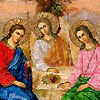 Painting is not the only technique used for creating Russian icons. When glass beads
came to Russia, beadwork started to be used by monastery icon artists. All iconography
traditions are kept and developed by many Russian modern artists. Two sisters - Anna
Bandurkina and Olga Yantovskaya live in Central Russia, in the very old city of Ryazan,
that is rich in history, art, and culture. Their mother is an arts critic, about 25
years ago she learned the art of beaded icons, created her own techniques and methods
and inspired her daughters. Anna is an artist, Olga is a musician, and both of them have
now two passions: Russian icons and beading.
Painting is not the only technique used for creating Russian icons. When glass beads
came to Russia, beadwork started to be used by monastery icon artists. All iconography
traditions are kept and developed by many Russian modern artists. Two sisters - Anna
Bandurkina and Olga Yantovskaya live in Central Russia, in the very old city of Ryazan,
that is rich in history, art, and culture. Their mother is an arts critic, about 25
years ago she learned the art of beaded icons, created her own techniques and methods
and inspired her daughters. Anna is an artist, Olga is a musician, and both of them have
now two passions: Russian icons and beading.
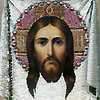 The size of sisters' icons is usually 8.3 x 11.4 inches (21 x 29 centimeters). Faces,
hands and some other elements of the icons are painted on thin canvas and glued. Anna
and Olga use in their work glass beads of many sizes, types and colors, rhinestones,
Swarovski crystal, pearl, amber, and gemstones; they donate icons to local Russian
Orthodox monasteries. Surf
the gallery to see the beaded icons by Anna and Olga. Visit
their website to see much more wonderful Russian beaded icons. If you are
interested in beaded icon art, please contact Anna and Olga at
ikona.72@mail.ru, or you may contact us at
info@mylovelybeads.com.
The size of sisters' icons is usually 8.3 x 11.4 inches (21 x 29 centimeters). Faces,
hands and some other elements of the icons are painted on thin canvas and glued. Anna
and Olga use in their work glass beads of many sizes, types and colors, rhinestones,
Swarovski crystal, pearl, amber, and gemstones; they donate icons to local Russian
Orthodox monasteries. Surf
the gallery to see the beaded icons by Anna and Olga. Visit
their website to see much more wonderful Russian beaded icons. If you are
interested in beaded icon art, please contact Anna and Olga at
ikona.72@mail.ru, or you may contact us at
info@mylovelybeads.com.
|
Step by step
Have you ever tried to make a small piece of jewelry of your own, just for your own
pleasure? For those who want to try it since that issue we will tell about the small
jewelry making secrets of Tatiana Van Iten. Tatiana has a great experience in
designing and creating beaded jewelry, and she has kindly agreed to share with us
some of her skills. Today Tatiana shows us how to make a simple
Cuff Bracelet.
|
Upcoming events
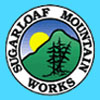 Sugarloaf Craft Festivals
Sugarloaf Craft Festivals
|
November 9, 10, 11, 2007
Hartford, Connecticut
Connecticut Expo Center
|
|
November 16, 17, 18, 2007
Gaithersburg, Maryland
Mont. Co. Fairgrounds
|
Juried Fine Art & Craft Festivals since 1976. Find the unique handcrafted artwork of
thousands of American Artists! Sugarloaf Craft Festivals are designer craft shows and
fine art fairs with a difference. Decorative creations for home & garden, exceptional
fine art & designer crafts!
|
|





 Opal is truly amorphous, but precious opal has a structural element. At the micro
scale precious opal is composed of silica spheres, that produce a variable interplay
of internal colors by causing the interference and diffraction of light passing
through the microstructure of opal. The term opalescence is commonly and erroneously
used to describe this unique phenomenon, which is correctly termed play of color.
Contrarily, opalescence is correctly applied to the milky, turbid appearance of common
opal, that does not show a play of color.
Opal is truly amorphous, but precious opal has a structural element. At the micro
scale precious opal is composed of silica spheres, that produce a variable interplay
of internal colors by causing the interference and diffraction of light passing
through the microstructure of opal. The term opalescence is commonly and erroneously
used to describe this unique phenomenon, which is correctly termed play of color.
Contrarily, opalescence is correctly applied to the milky, turbid appearance of common
opal, that does not show a play of color.
 Besides the gemstone varieties that show a play of color, there are other kinds of
common opal that don't have this effect, such as the milk opal, milky bluish to greenish;
resin opal, honey-yellow with a resinous luster; wood opal; menilite brown or gray;
hyalite, a colorless glass-clear opal; geyserite, deposited around hot springs or
geysers; and diatomite, the accumulations of diatom shells or tests. Other varieties
of opal are: fire opal is a translucent to semi-opaque stone that is generally
yellow to bright orange and sometimes nearly red; peruvian opal is a semi-opaque
to opaque blue-green stone found in Peru; boulder opal consists of concretions
and fracture fillings in a dark siliceous ironstone matrix.
Besides the gemstone varieties that show a play of color, there are other kinds of
common opal that don't have this effect, such as the milk opal, milky bluish to greenish;
resin opal, honey-yellow with a resinous luster; wood opal; menilite brown or gray;
hyalite, a colorless glass-clear opal; geyserite, deposited around hot springs or
geysers; and diatomite, the accumulations of diatom shells or tests. Other varieties
of opal are: fire opal is a translucent to semi-opaque stone that is generally
yellow to bright orange and sometimes nearly red; peruvian opal is a semi-opaque
to opaque blue-green stone found in Peru; boulder opal consists of concretions
and fracture fillings in a dark siliceous ironstone matrix.




 Joan Jensen and Ernie Morse of Tazwood Creations
Joan Jensen and Ernie Morse of Tazwood Creations
